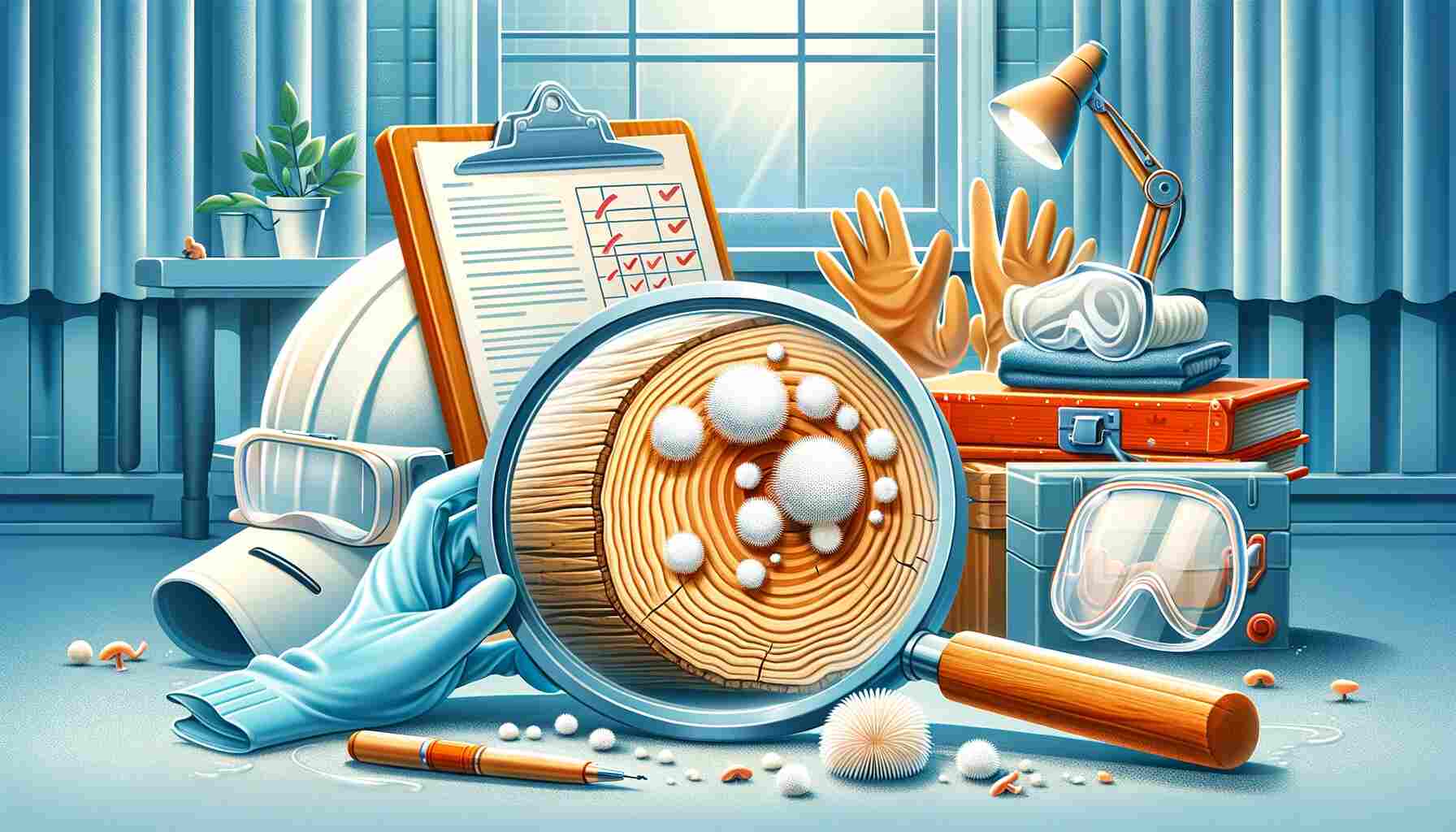White mold on wood can be a concerning sight for homeowners and property managers. Not only does it affect the aesthetics of wood surfaces, but it also raises questions about potential health risks and structural damage.
In this guide, we’ll dive into the nature of white mold on wood, its potential dangers, and how to effectively manage and prevent its growth.
Understanding White Mold
White mold, also known as wood rot or saprophytic fungi, is a type of fungus that thrives in moist environments. It often appears as a powdery or fuzzy white substance on wood surfaces, ranging from walls and floors to furniture and structural components. This mold is commonly associated with damp or humid conditions, making it prevalent in areas such as basements, bathrooms, and attics.
Is White Mold on Wood Dangerous?
The presence of white mold on wood can raise concerns about potential health hazards. While not all molds are inherently harmful, some species of white mold can produce mycotoxins, which may pose health risks to humans and pets when exposed in large quantities. Common symptoms of mold exposure include respiratory issues, allergic reactions, and skin irritation.
However, it’s essential to note that not all white molds produce mycotoxins, and the severity of health effects can vary depending on individual sensitivities and the extent of exposure. Nevertheless, any mold growth indoors should be taken seriously and addressed promptly to minimize potential health risks.
Identifying Dangerous White Mold Species
To determine whether white mold on wood poses a significant health risk, it’s crucial to identify the specific species present. Some common types of white mold that are known to produce mycotoxins include:
- Aspergillus: This genus of mold includes various species, some of which can produce mycotoxins such as aflatoxin, known for its carcinogenic properties.
- Penicillium: While often used in the production of antibiotics, certain species of Penicillium can produce mycotoxins and trigger allergic reactions in sensitive individuals.
- Stachybotrys: Also known as black mold, Stachybotrys chartarum can sometimes appear white when it’s in its early stages of growth. This mold is infamous for producing mycotoxins associated with severe health effects.
If you suspect the presence of any of these mold species, it’s advisable to consult with a professional mold inspector or remediation specialist to assess the situation accurately.
Health Risks and Prevention of White Mold on Wood
Health Risks Associated with White Mold
White mold on wood, a common issue in damp environments, can pose various health risks to individuals, particularly those with allergies, asthma, or compromised immune systems. According to the Centers for Disease Control and Prevention (CDC), exposure to mold can cause symptoms such as stuffy nose, sore throat, coughing or wheezing, burning eyes, or skin rash. People with asthma or mold allergies may experience severe reactions, and immune-compromised individuals are at risk of lung infections from mold exposure.
The Environmental Protection Agency (EPA) also emphasizes that molds, including white mold, produce allergens, irritants, and in some cases, potentially toxic substances known as mycotoxins. These can lead to allergic reactions, characterized by hay fever-type symptoms, such as sneezing, runny nose, red eyes, and skin rash. Moreover, molds can trigger asthma attacks in individuals who are allergic.
Preventing White Mold Growth
Preventing white mold growth on wood surfaces is crucial to avoid the potential health risks associated with mold exposure. The CDC and EPA both highlight the importance of moisture control as the key to mold prevention. Recommendations include:
- Controlling indoor humidity levels to between 30% and 50% all day long, using air conditioners or dehumidifiers as necessary.
- Promptly repairing leaky roofs, windows, and pipes to prevent moisture from entering and accumulating in your home.
- Ensuring proper ventilation in high-moisture areas such as bathrooms and kitchens by using exhaust fans that vent outside.
- Cleaning and drying any water-damaged areas within 24-48 hours to prevent mold growth.
The National Institute of Environmental Health Sciences (NIEHS) adds that molds, including white mold, are microscopic organisms that play a crucial role in decomposing organic material. They can grow indoors on any surface where moisture, oxygen, and organic material are present. When molds are disturbed, they release spores into the air, leading to widespread exposure both indoors and outdoors. Thus, addressing any signs of moisture or water damage promptly is vital in preventing mold growth.
Understanding the potential health risks associated with white mold on wood and implementing effective moisture control and mold prevention strategies can significantly reduce the likelihood of mold-related health issues.
Here is how to get rid of mold on firewood.
Key Takeaways
- Nature and Risks of White Mold: White mold, or saprophytic fungi, thrives in moist environments and can be found on wood surfaces. While not all white molds are harmful, some species produce mycotoxins that pose health risks, including respiratory issues, allergic reactions, and skin irritation.
- Identifying Dangerous Species: Common harmful white mold species include Aspergillus, Penicillium, and Stachybotrys (sometimes appearing white in early growth stages). Professional inspection is recommended to accurately identify and assess the risk.
- Health Implications: Exposure to white mold can lead to respiratory problems, allergic reactions, and in rare cases, fungal infections, particularly in those with compromised immune systems or respiratory conditions.
- Prevention and Management: Addressing moisture issues, improving ventilation, monitoring indoor humidity, and regular maintenance of wood surfaces are crucial steps to prevent white mold growth. Using mold-resistant products and quickly addressing water damage can also help mitigate risks.
- When to Seek Professional Help: For significant infestations or if toxic mold species are suspected, professional remediation is advised to safely and effectively remove the mold and prevent future growth.
- White Mold vs. Other Fungi: Distinguishing white mold from mildew or efflorescence is important for appropriate treatment. Although less dangerous than black mold, white mold still requires immediate attention to prevent health risks and structural damage.
Conclusion
White mold is a toxic fungus that, despite its name, can appear in various colors such as white, grey, or green depending on the surface it grows on. Commonly found in high moisture areas like basements and bathrooms, it poses health risks similar to black mold, including respiratory issues and structural damage to buildings.
Identifying white mold involves recognizing its appearance, typically fuzzy or powdery, and understanding its health implications. Professional removal is recommended for significant infestations, but smaller outbreaks can be addressed with precautions like protective gear and proper ventilation.
Symptoms of white mold exposure include respiratory problems, skin irritation, and allergic reactions. Treating white mold on plants involves pruning affected parts, improving ventilation, adjusting watering practices, and applying organic fungicides.
Distinguishing white mold from mildew or efflorescence involves observing its growth pattern and location. Unlike black mold, white mold is less dangerous but still requires immediate attention. If you suspect the presence of toxic mold species or experience persistent health symptoms related to mold exposure, seek professional assistance to assess and remediate the situation appropriately.
For more detailed information on mold and health effects, please consult the CDC and EPA guidelines, as well as the NIEHS resources on environmental health and mold exposure.





